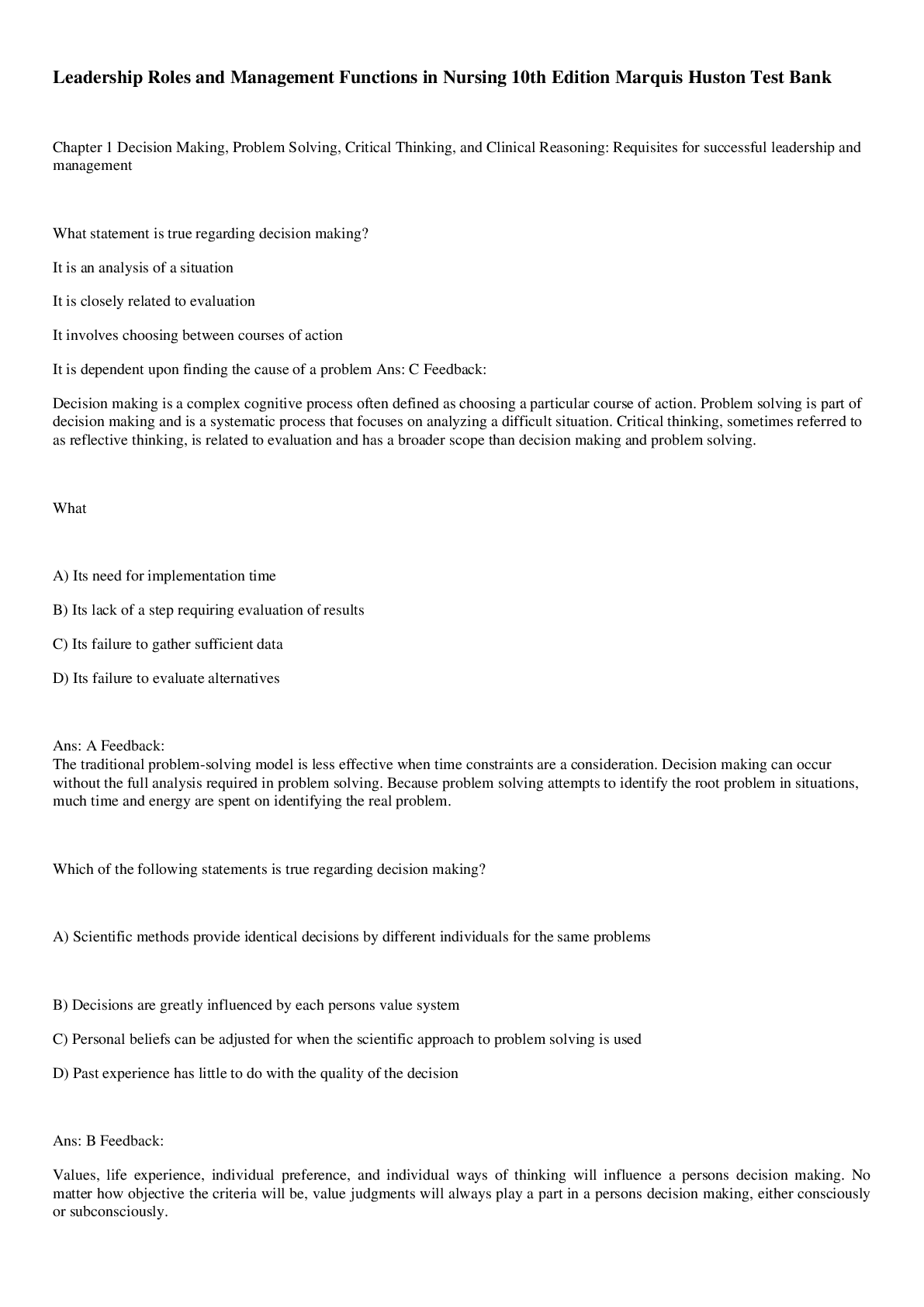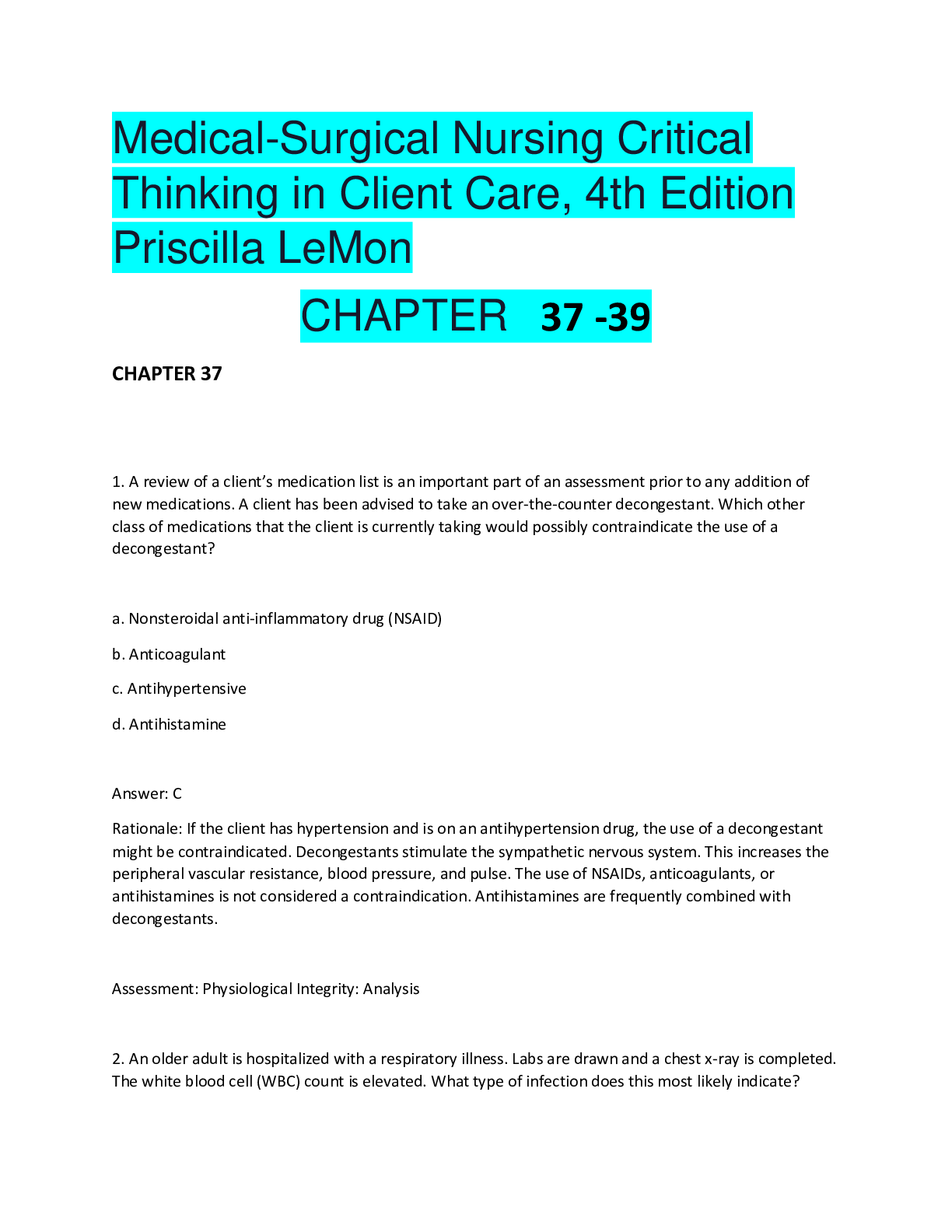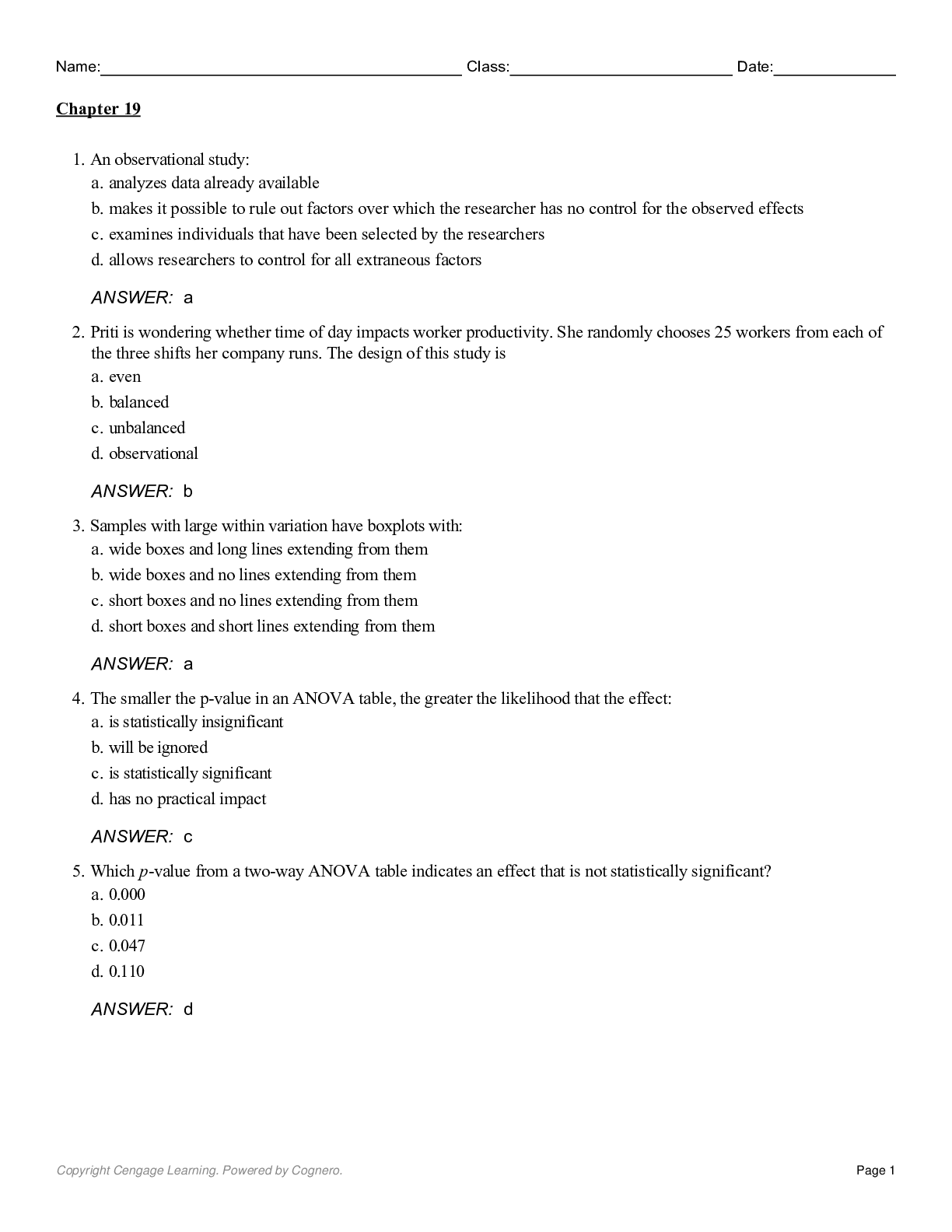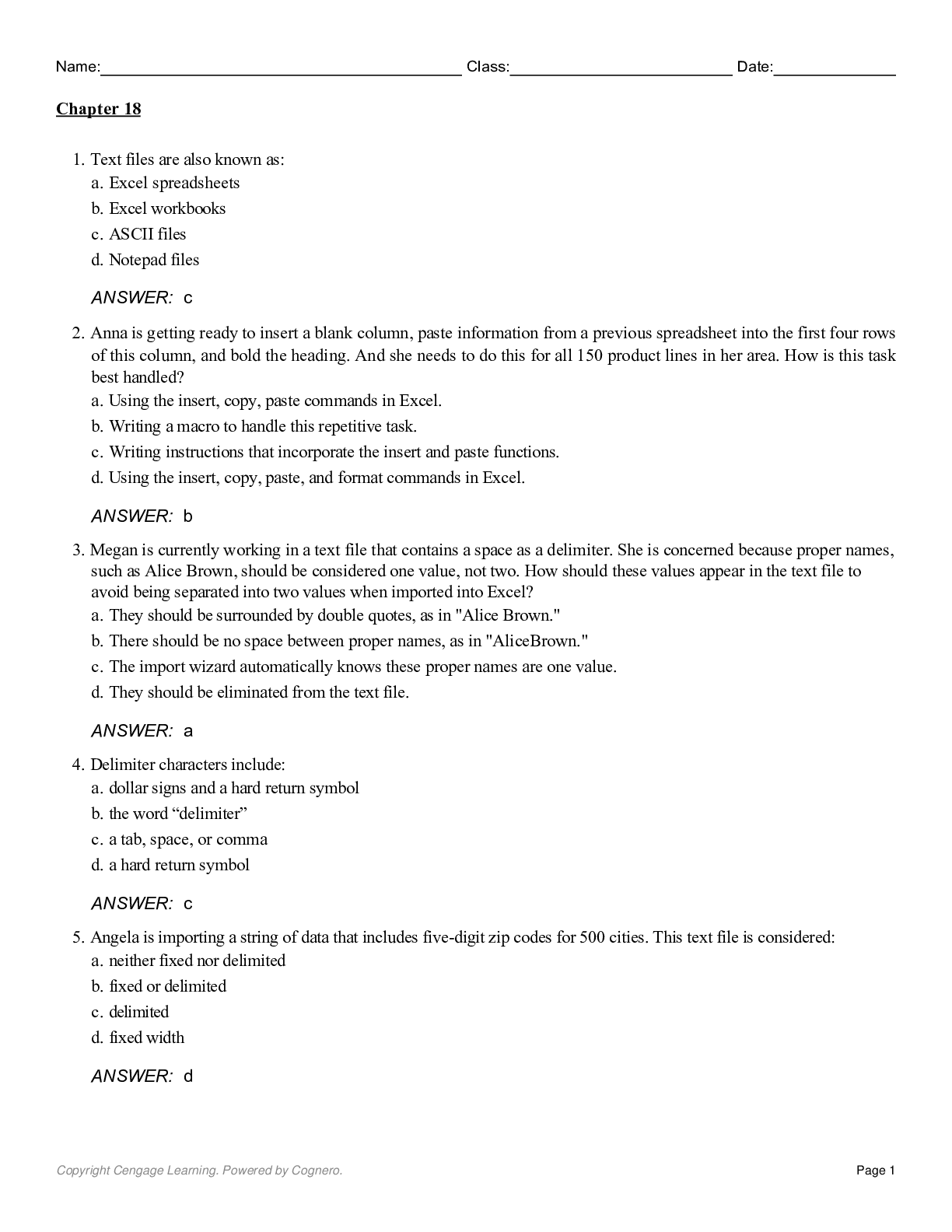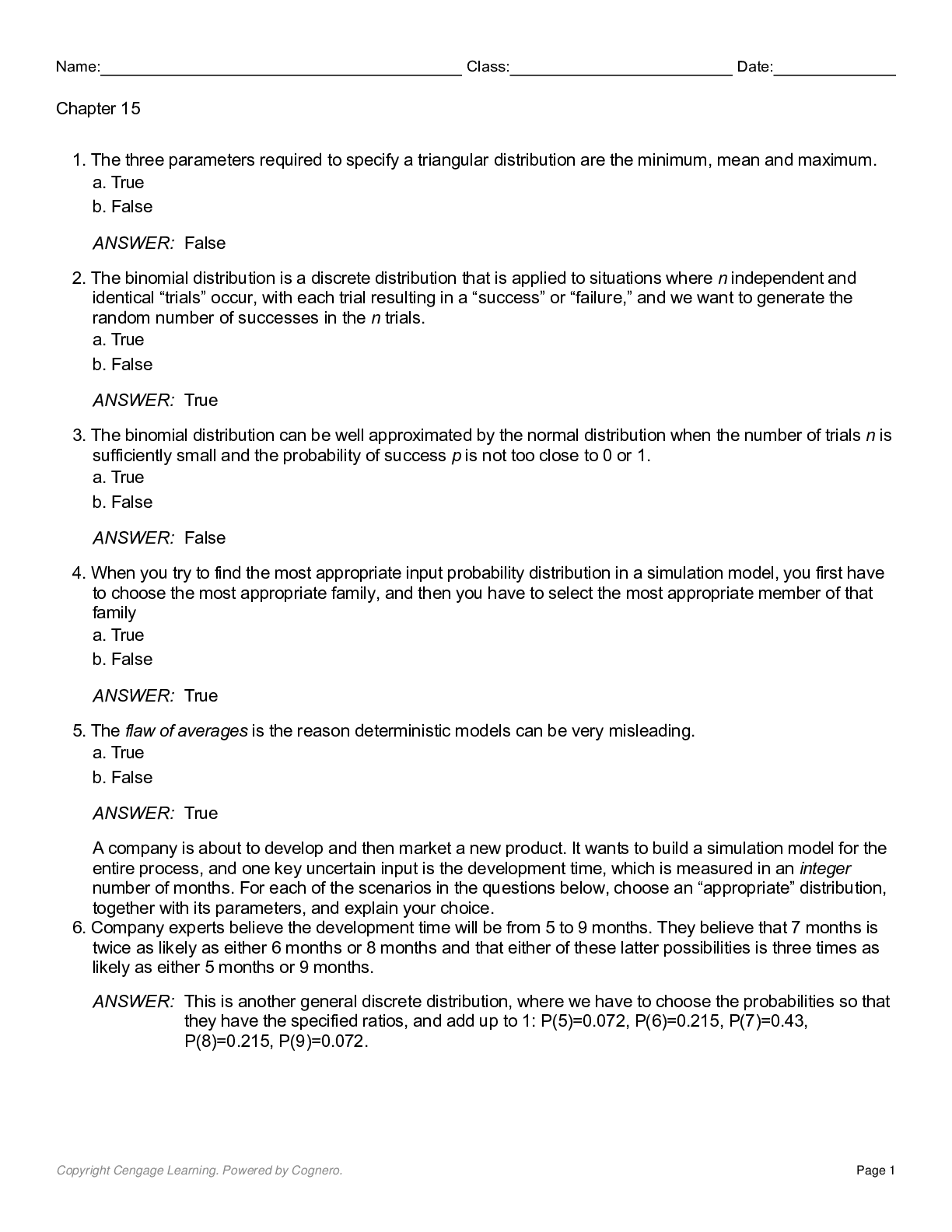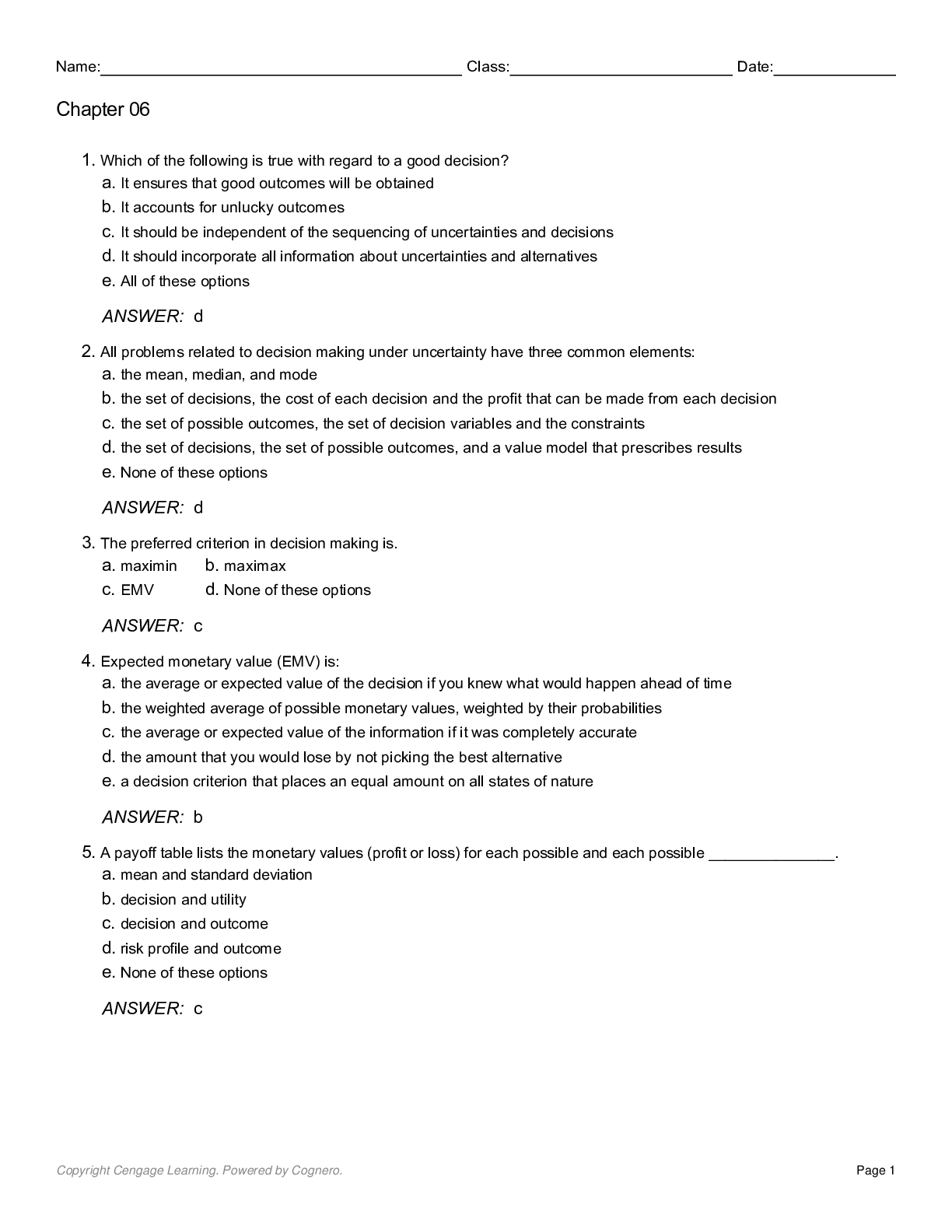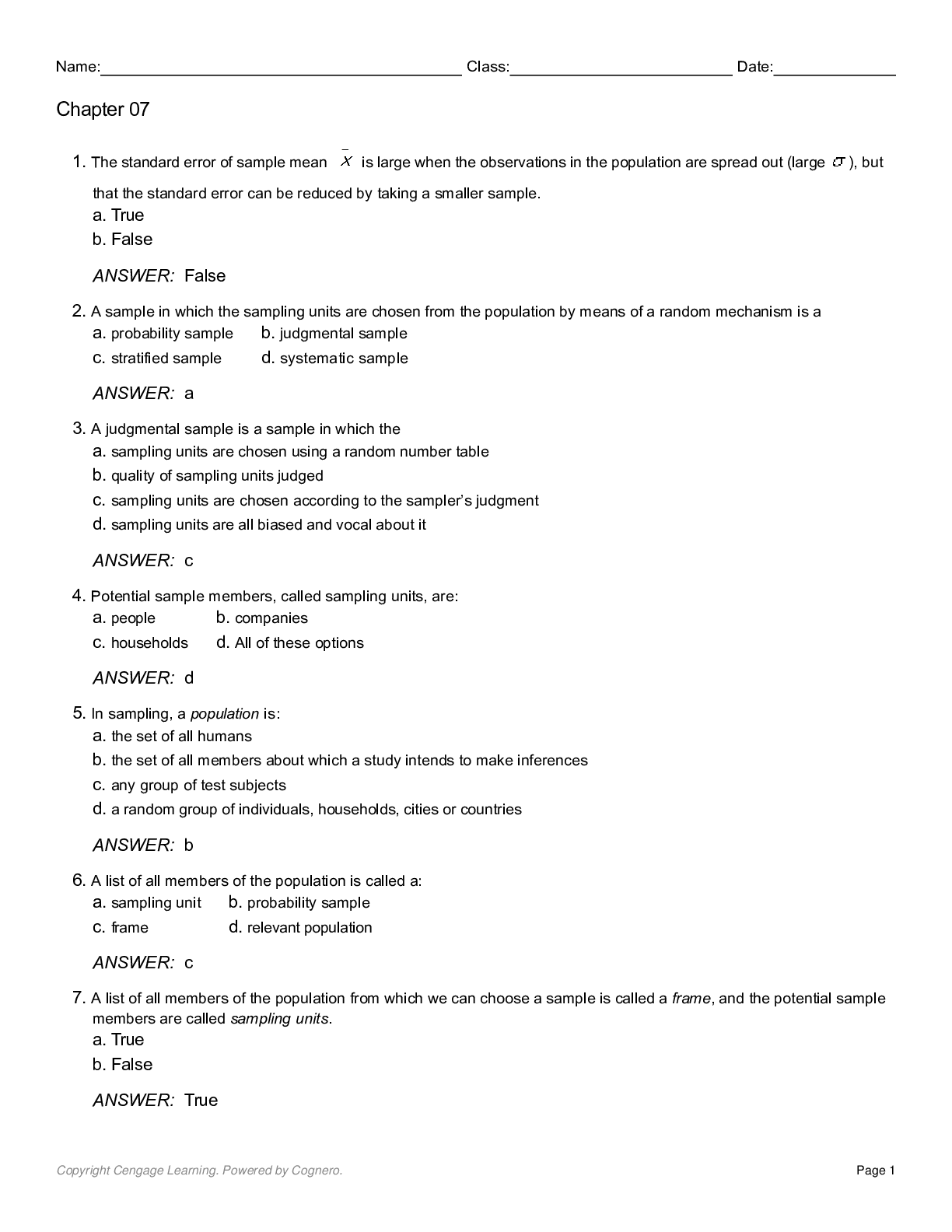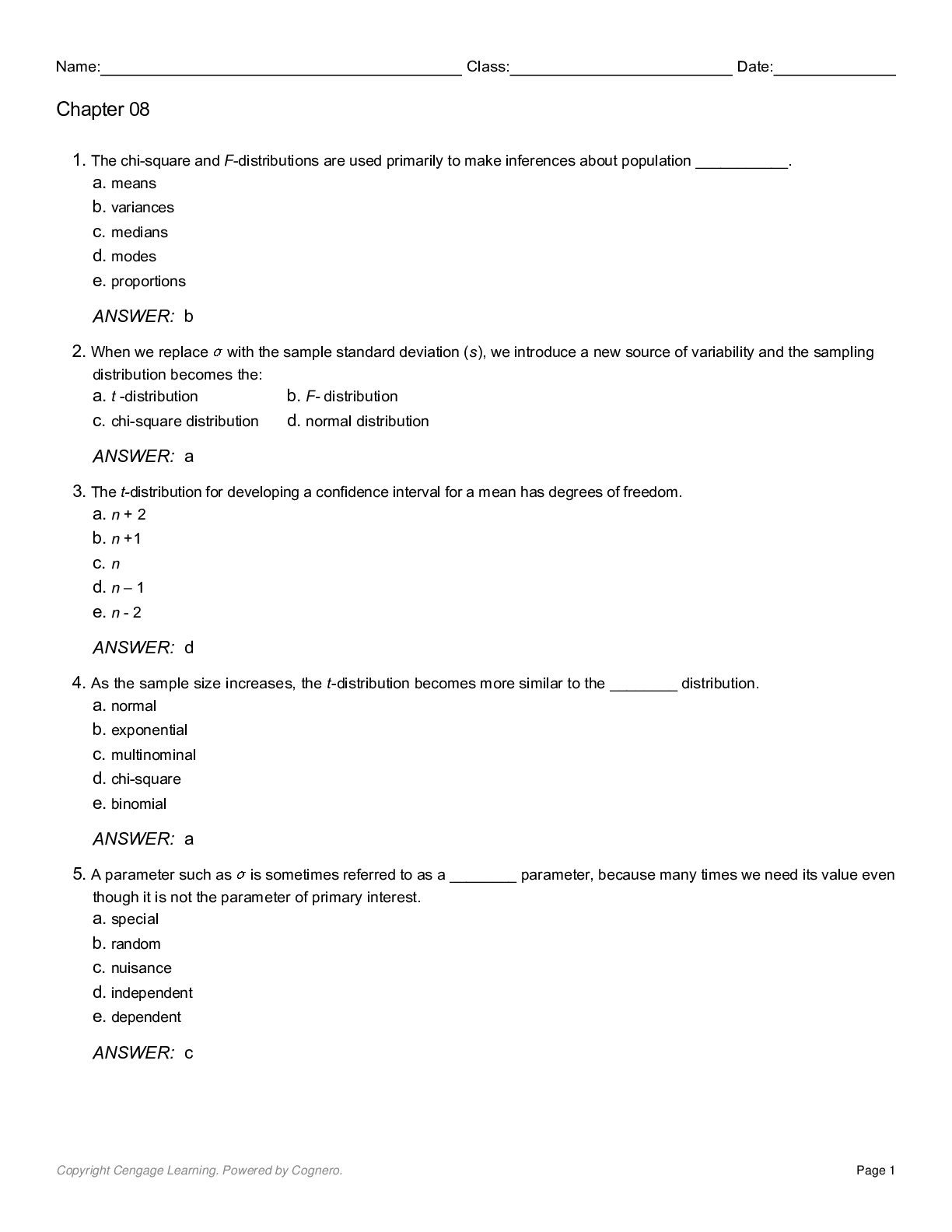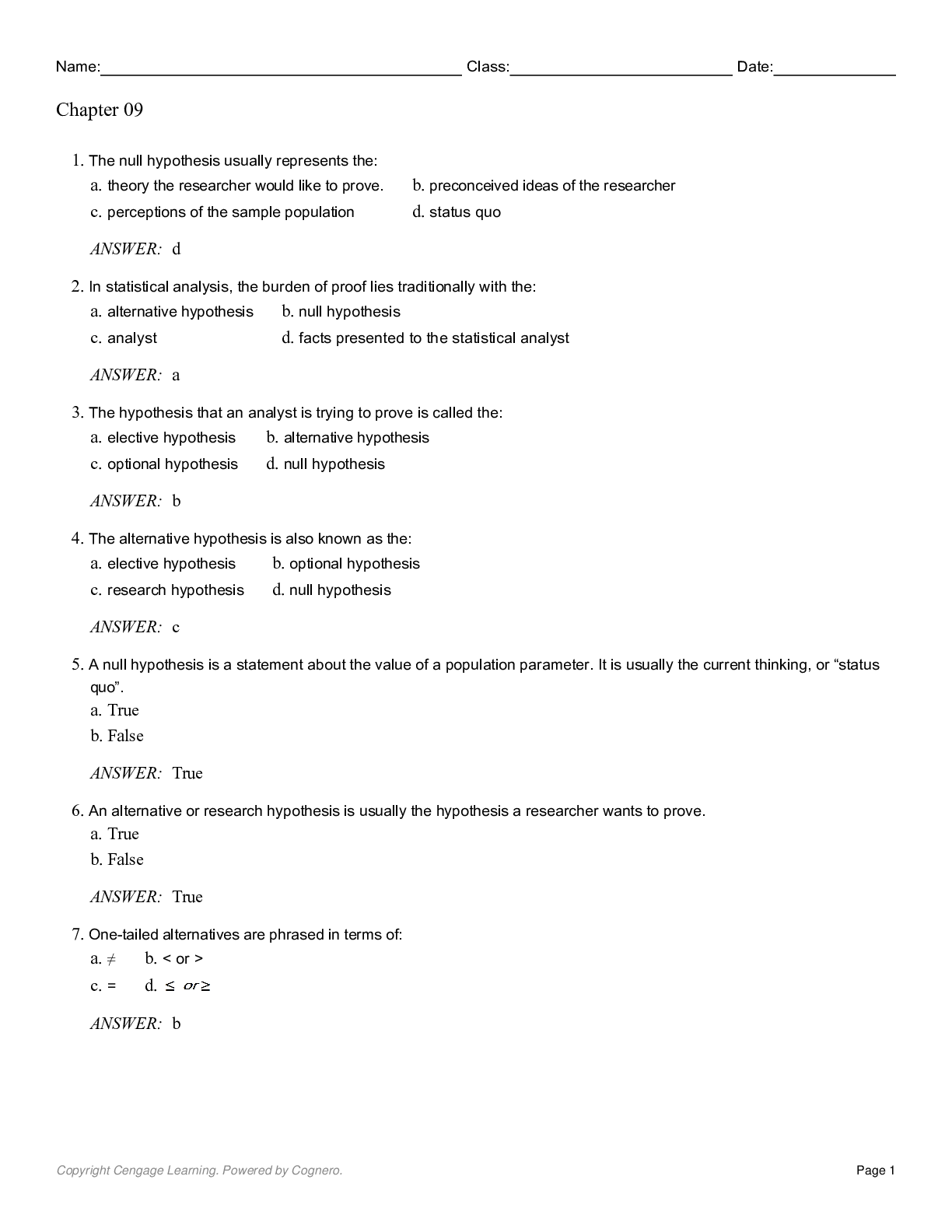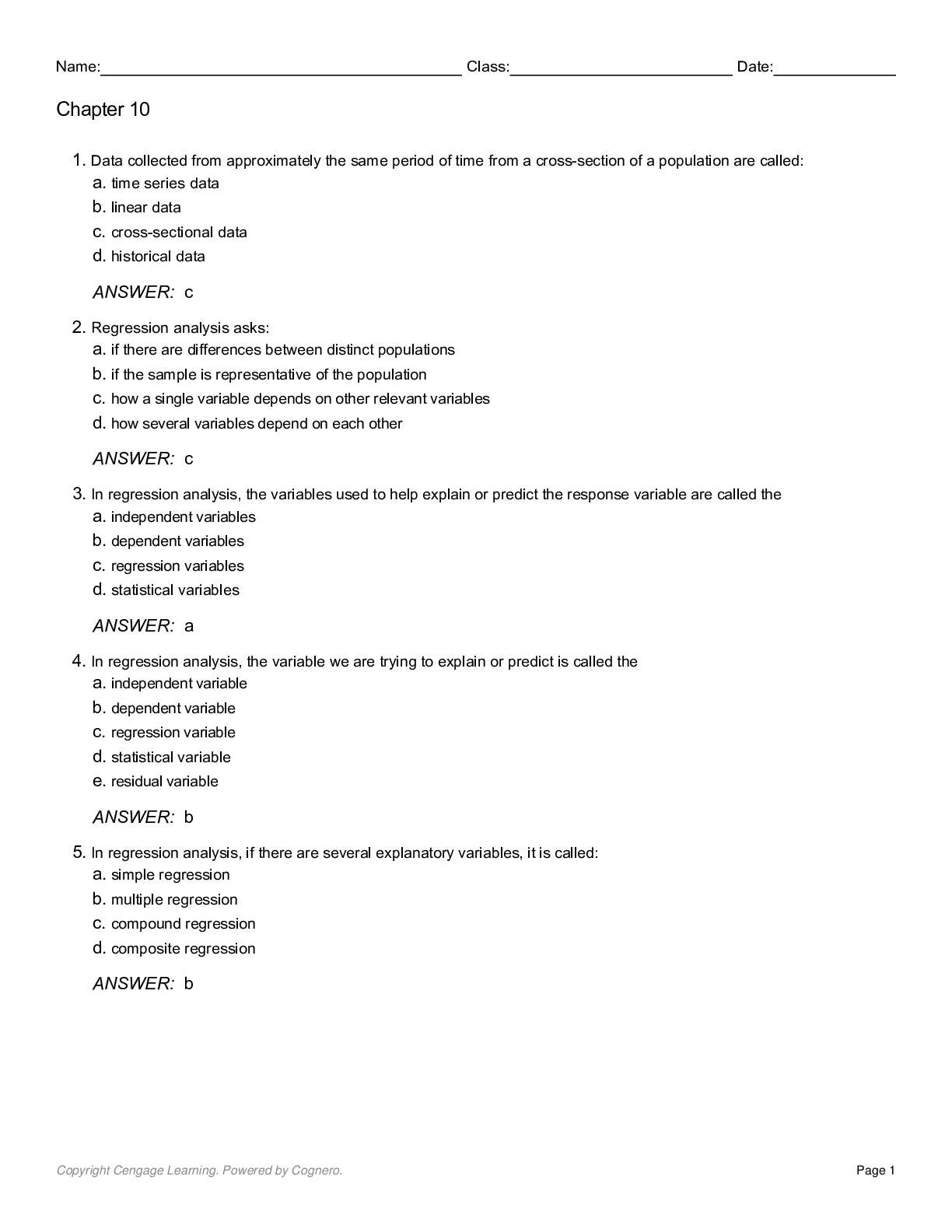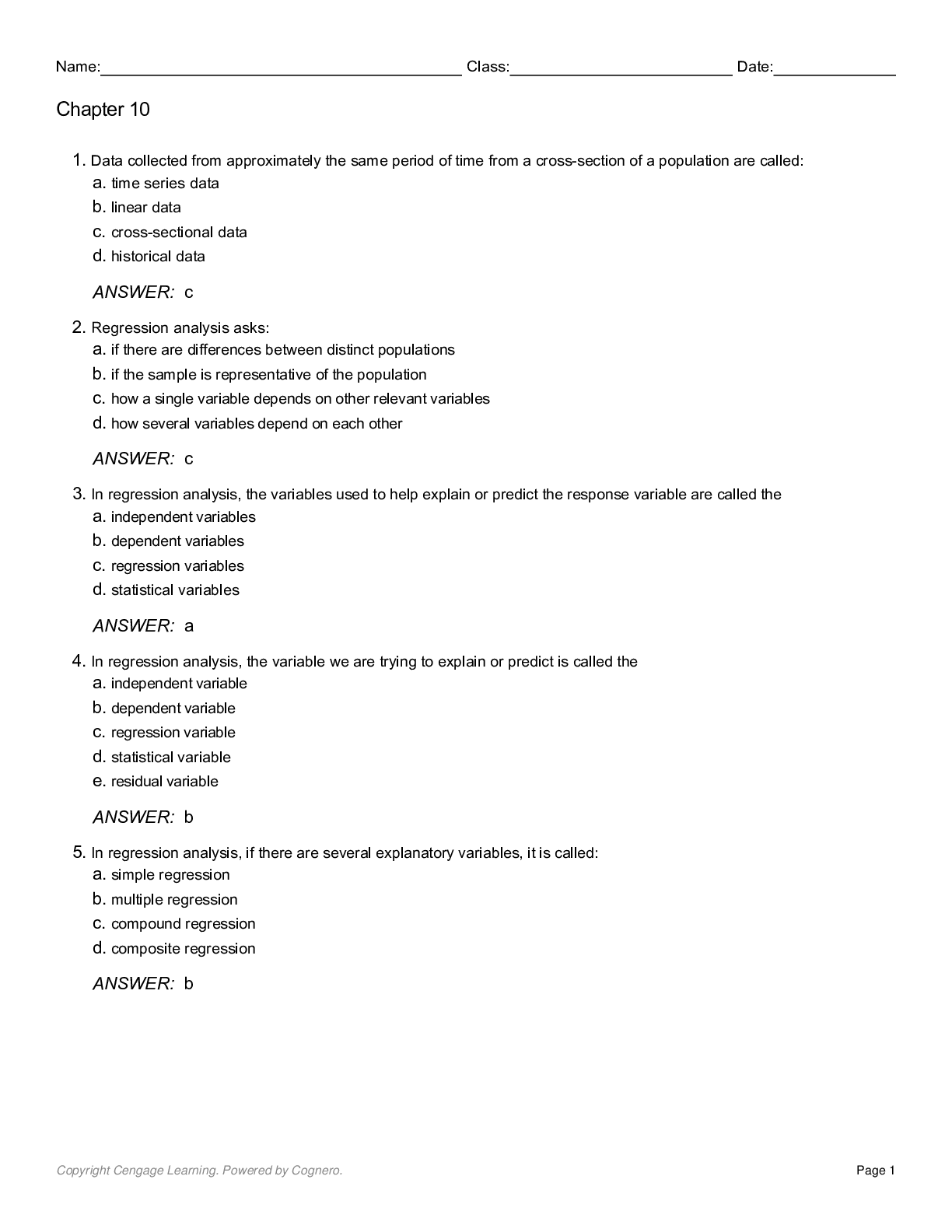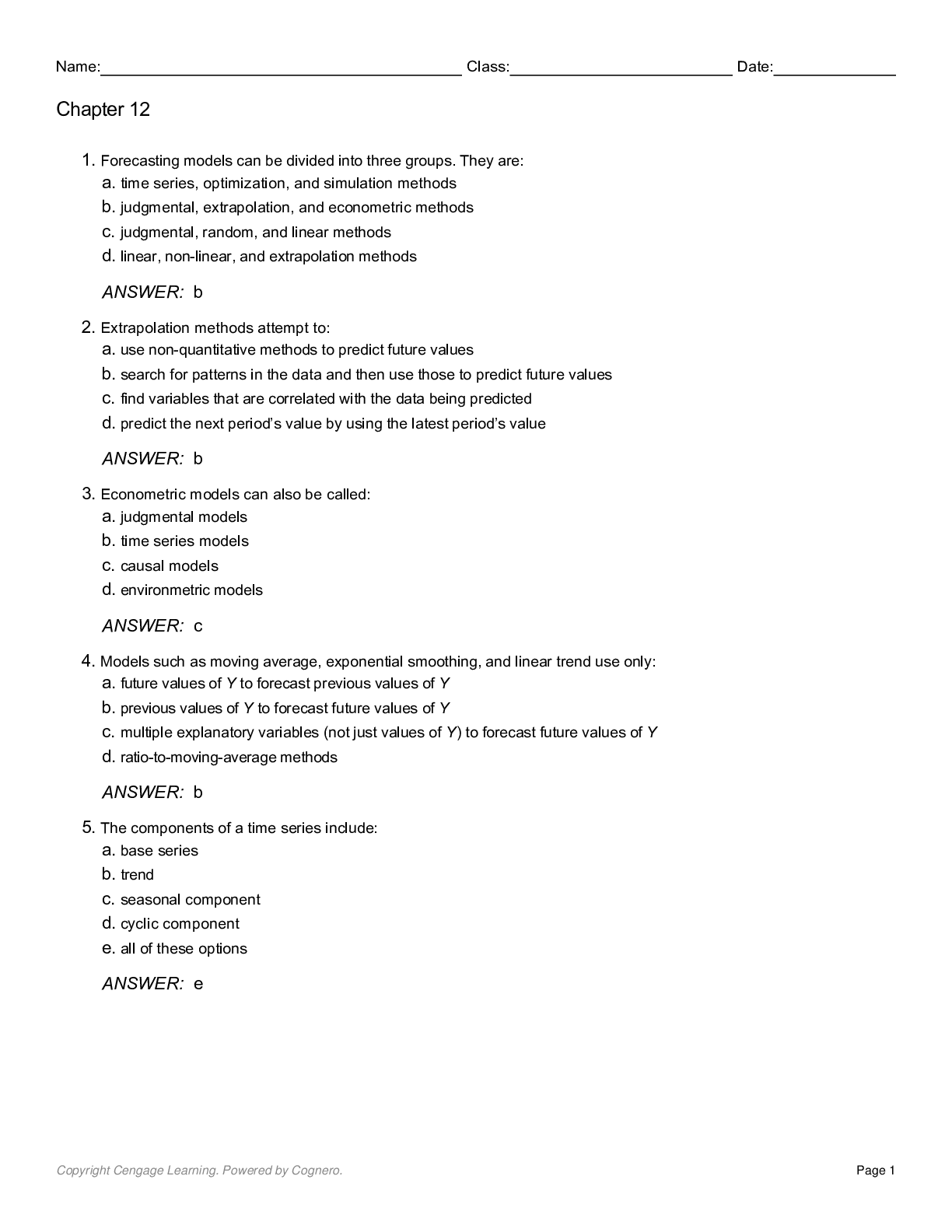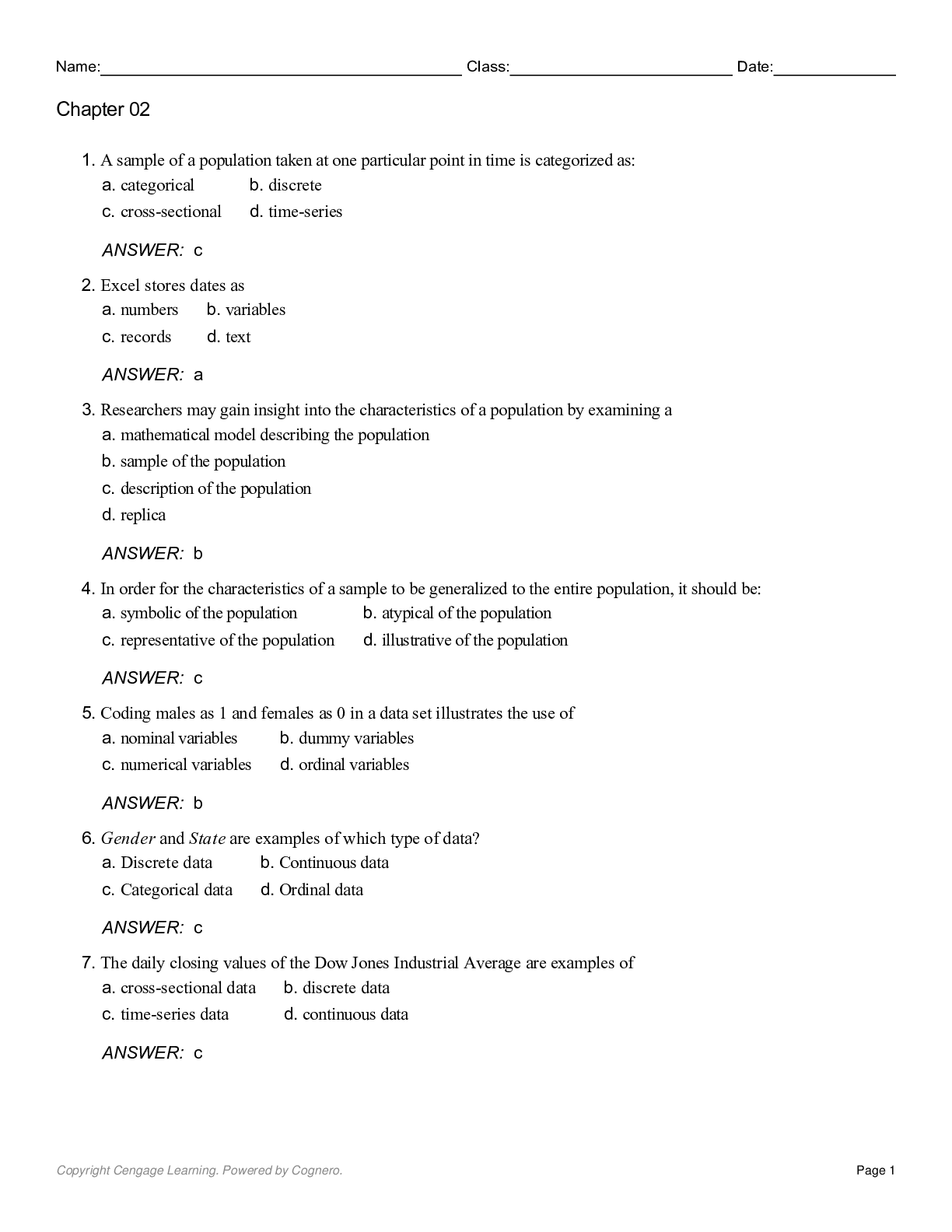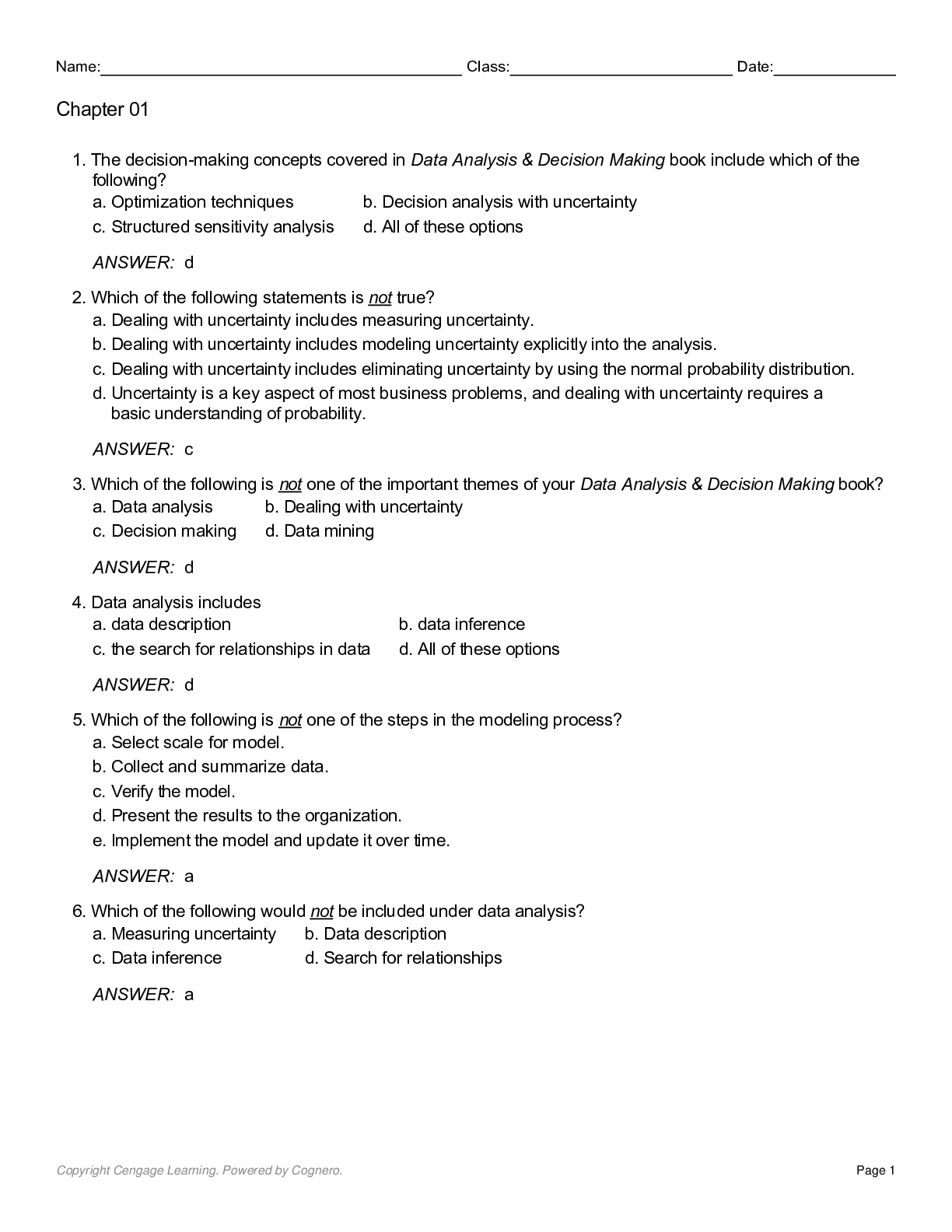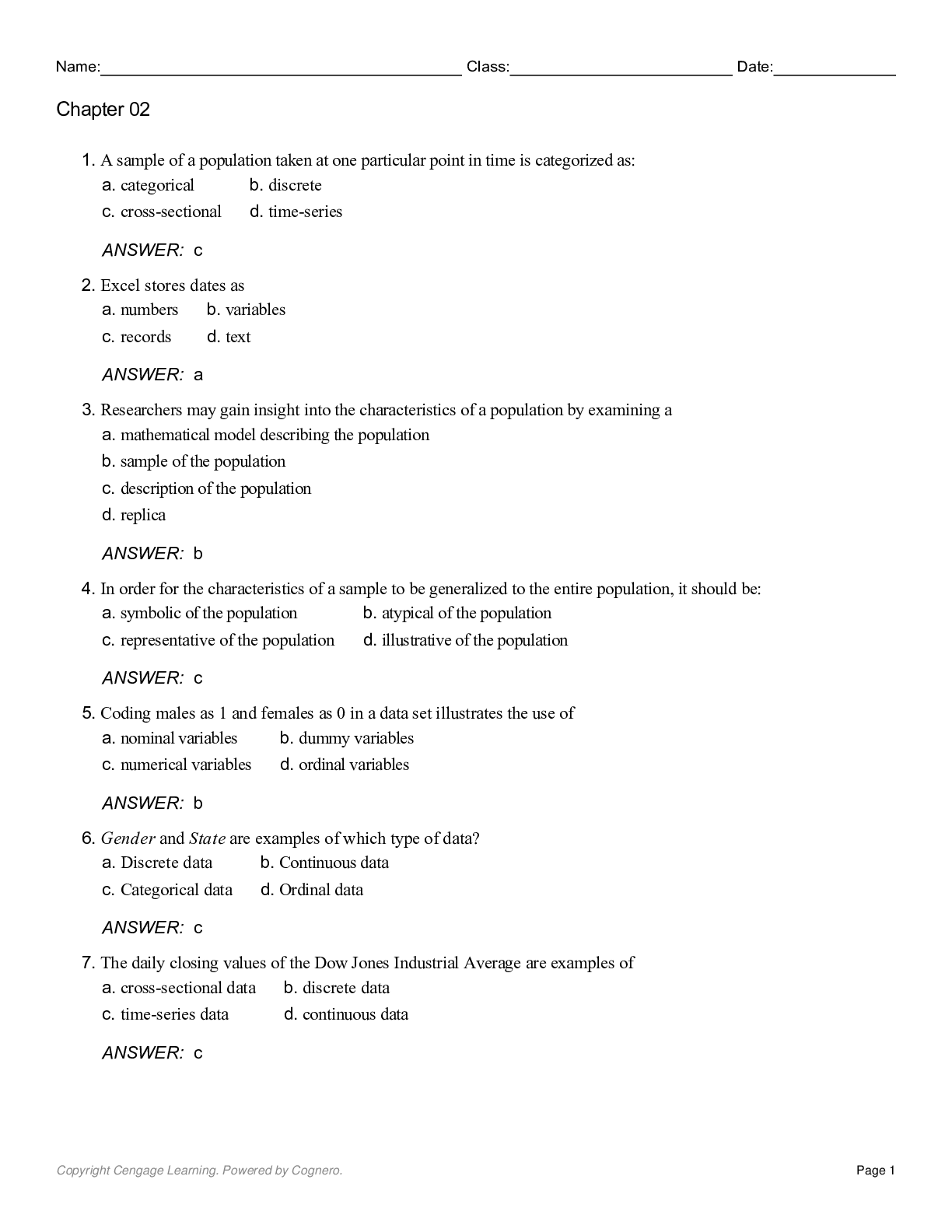Business Analytics > QUESTIONS & ANSWERS > Chapter 4: Business Analytics_ Data Analysis _ Decision Making (All)
Chapter 4: Business Analytics_ Data Analysis _ Decision Making
Document Content and Description Below
Name: Class: Date: Chapter 04 1. Probabilities that cannot be estimated from long-run relative frequenc... ies of events are a. objective probabilities b. subjective probabilities c. complementary probabilities d. joint probabilities 2. The probability of an event and the probability of its complement always sum to a. 1 b. 0 c. any value between 0 and 1 d. any positive value 3. If events A and B are mutually exclusive, then the probability of both events occurring simultaneously is equal to a. 0.0 b. 0.5 c. 1.0 d. any value between 0.5 and 1.0 4. Probabilities that can be estimated from long-run relative frequencies of events are a. objective probabilities b. subjective probabilities c. complementary probabilities d. joint probabilities 5. Let A and B be the events of the FDA approving and rejecting a new drug to treat hypertension, respectively. The events A and B are a. independent b. conditional c. unilateral d. mutually exclusive 6. A function that associates a numerical value with each possible outcome of an uncertain event is called a a. conditional variable b. random variable c. population variable d. sample variable 7. The formal way to revise probabilities based on new information is to use: a. complementary probabilities b. conditional probabilities c. unilateral probabilities d. common sense probabilities 8. is the: a. addition rule b. commutative rule c. rule of complements d. rule of opposites Copyright Cengage Learning. Powered by Cognero. Page 1 Name: Class: Date: Chapter 04 9. The law of large numbers is relevant to the estimation of a. objective probabilities b. subjective probabilities c. both objective and subjective probabilities d. neither objective nor subjective probabilities 10. A discrete probability distribution: a. lists all of the possible values of the random variable and their corresponding probabilities b. is a tool that can be used to incorporate uncertainty into models c. can be estimated from long-run proportions d. is the distribution of a single random variable 11. Which of the following statements are true? a. Probabilities must be negative b. Probabilities must be greater than 1 c. The sum of all probabilities for a random variable must be equal to 1 d. All of these options are true. 12. If P(A) = P(A|B), then events A and B are said to be a. mutually exclusive b. independent c. exhaustive d. complementary 13. If A and B are mutually exclusive events with P(A) = 0.70, then P(B): a. can be any value between 0 and 1 b. can be any value between 0 and 0.70 c. cannot be larger than 0.30 d. Cannot be determined with the information given 14. If two events are collectively exhaustive, what is the probability that one or the other occurs? a. 0.25 b. 0.50 c. 1.00 d. Cannot be determined from the information given. Copyright Cengage Learning. Powered by Cognero. Page 2 Name: Class: Date: Chapter 04 15. If two events are collectively exhaustive, what is the probability that both occur at the same time? a. 0.00 b. 0.50 c. 1.00 d. Cannot be determined from the information given. 16. The probabilities shown in a table with two rows, and two columns, , are as follows: , , , and . Then , calculated up to two decimals, is a. .33 b. .35 c. .65 d. .67 17. If two events are mutually exclusive, what is the probability that one or the other occurs? a. 0.25 b. 0.50 c. 1.00 d. Cannot be determined from the information given. 18. If two events are mutually exclusive, what is the probability that both occur at the same time? a. 0.00 b. 0.50 c. 1.00 d. Cannot be determined from the information given. 19. If two events are mutually exclusive and collectively exhaustive, what is the probability that both occur? a. 0.00 b. 0.50 c. 1.00 d. Cannot be determined from the information given. 20. There are two types of random variables, they are a. discrete and continuous b. exhaustive and mutually exclusive c. complementary and cumulative d. real and unreal Copyright Cengage Learning. Powered by Cognero. Page 3 Name: Class: Date: Chapter 04 21. If P(A) = 0.25 and P(B) = 0.65, then P(A and B) is: a. 0.25 b. 0.40 c. 0.90 d. Cannot be determined from the information given 22. If two events are independent, what is the probability that they both occur? a. 0 b. 0.50 c. 1.00 d. Cannot be determined from the information given 23. If A and B are any two events with = .8 and , then is a. .56 b. .14 c. .24 d. None of these options. 24. Which of the following best describes the concept of probability? a. It is a measure of the likelihood that a particular event will occur. b. It is a measure of the likelihood that a particular event will occur, given that another event has already occurred. c. It is a measure of the likelihood of the simultaneous occurrence of two or more events. d. None of these options. 25. The probabilities shown in a table with two rows, and two columns, , are as follows: , , , and . Then , calculated up to two decimals, is a. .33 b. .35 c. .65 d. .67 26. If A and B are mutually exclusive events with P(A) = 0.30 and P(B) = 0.40, then the probability that either A or B occur is: a. 0.10 b. 0.12 c. 0.70 d. None of these options. Copyright Cengage Learning. Powered by Cognero. Page 4 Name: Class: Date: Chapter 04 27. If A and B are any two events with P(A) = .8 and P(B|A) = .4, then the joint probability of A and B is a. .80 b. .40 c. .32 d. 1.20 28. If A and B are independent events with P(A) = 0.40 and P(B) = 0.50, then P(A/B) is 0.50. a. True b. False 29. A random variable is a function that associates a numerical value with each possible outcome of a random phenomenon. a. True b. False 30. Two or more events are said to be exhaustive if one of them must occur. a. True b. False 31. You think you have a 90% chance of passing your statistics class. This is an example of subjective probability. a. True b. False 32. The number of cars produced by GM during a given quarter is a continuous random variable. a. True b. False 33. Two events A and B are said to be independent if P(A and B) = P(A) + P(B) a. True b. False 34. Probability is a number between 0 and 1, inclusive, which measures the likelihood that some event will occur. a. True b. False Copyright Cengage Learning. Powered by Cognero. Page 5 Name: Class: Date: Chapter 04 35. If events A and B have nonzero probabilities, then they can be both independent and mutually exclusive. a. True b. False 36. The probability that event A will not occur is denoted as . a. True b. False 37. If P(A and B) = 1, then A and B must be collectively exhaustive. a. True b. False 38. Conditional probability is the probability that an event will occur, with no other events taken into consideration. a. True b. False 39. When we wish to determine the probability that at least one of several events will occur, we would use the addition rule. a. True b. False 40. The law of large numbers states that subjective probabilities can be estimated based on the long run relative frequencies of events a. True b. False 41. Two events are said to be independent when knowledge of one event is of no value when assessing the probability of the other. a. True b. False Copyright Cengage Learning. Powered by Cognero. Page 6 Name: Class: Date: Chapter 04 42. Suppose A and B are mutually exclusive events where P(A) = 0.2 and P(B) = 0.5, then P(A or B) = 0.70. a. True b. False 43. If A and B are two independent events with P(A) = 0.20 and P(B) = 0.60, then P(A and B) = 0.80 a. True b. False 44. The relative frequency of an event is the number of times the event occurs out of the total number of times the random experiment is run. a. True b. False 45. Subjective probability is the probability that a given event will occur, given that another event has already occurred. a. True b. False 46. The temperature of the room in which you are writing this test is a continuous random variable. a. True b. False 47. Two events A and B are said to mutually be exclusive if P(A and B) = 0. a. True b. False 48. Two or more events are said to be exhaustive if at most one of them can occur. a. True b. False 49. When two events are independent, they are also mutually exclusive. a. True b. False Copyright Cengage Learning. Powered by Cognero. Page 7 Name: Class: Date: Chapter 04 50. Two or more events are said to be mutually exclusive if at most one of them can occur. a. True b. False 51. Given that events A and B are independent and that P(A) = 0.8 and P(B/A) = 0.4, then P(A and B) = 0.32. a. True b. False 52. The time students spend in a computer lab during one day is an example of a continuous random variable. a. True b. False 53. The multiplication rule for two events A and B is: P(A and B) = P(A|B)P(A). a. True b. False 54. The number of car insurance policy holders is an example of a discrete random variable. a. True b. False 55. Suppose A and B are mutually exclusive events where P(A) = 0.3 and P(B) = 0.4, then P(A and B) = 0.12. a. True b. False 56. Suppose A and B are two events where P(A) = 0.5, P(B) = 0.4, and P(A and B) = 0.2, then P(B/A) = 0.5. a. True b. False 57. Suppose that after graduation you will either buy a new car (event A) or take a trip to Europe (event B). Events A and B are mutually exclusive. a. True b. False Copyright Cengage Learning. Powered by Cognero. Page 8 Name: Class: Date: Chapter 04 58. If P(A and B) = 0, then A and B must be collectively exhaustive. a. True b. False 59. The number of people entering a shopping mall on a given day is an example of a discrete random variable. a. True b. False 60. Football teams toss a coin to see who will get their choice of kicking or receiving to begin a game. The probability that given team will win the toss three games in a row is 0.125. a. True b. False A manufacturing facility needs to open a new assembly line in four months or there will be significant cost overruns. The manager of this project believes that there are four possible values for the random variable X (the number of months from now it will take to complete this project): 3, 3.5, 4, and 4.5. It is currently believed that the probabilities of these four possibilities are in the ratio 1 to 2 to 3 to 2. That is, X = 3.5 is twice as likely as X = 3 and X = 4 is 1.5 times as likely as X = 3.5. 61. Find the probability distribution of X. ANSWER: x 3 3.5 4 4.5 P (X = x) 0.125 0.250 0.375 0.250 62. What is the probability that this project will be completed in less than 4 months from now? ANSWER: 63. What is the probability that this project will not be completed on time? ANSWER: 64. (A) What is the expected completion time (in months) from now for this project? (B) How much variability (in months) exists around the expected value found in (A)? ANSWER: (Copyright Cengage Learning. Powered by Cognero. Page 9 Name: Class: Date: Chapter 04 The possible annual percentage return of the stocks of Gamma, Inc. and Delta, Inc. share a common probability distribution, given below. Probability Return of Gamma, Inc. Return of Delta, Inc. 0.05 36.2 -6.4 0.15 23.4 -1.8 0.30 15.18 6.9 0.20 6.2 12.4 0.15 -2.0 16.8 0.05 -4.2 30.2 65. (A) What is the expected annual return of each stock? (B) What is the standard deviation of the annual return of each stock? (C) On the basis of your answers to (A) and (B), which of these stocks would you prefer to buy? Defend your choice. (D) Are the annual returns of these two stocks positively or negatively associated with each other? How might the answer to this question influence your decision to purchase shares? ANSWER: (A) Stock Expected Value Gamma 10.58 Delta 10.10 (B) Stock Standard Deviation Gamma 10.16 Delta 8.08 (C) Gamma has a higher expected annual return. However, Gamma is also more volatile with a higher standard deviation. Each stock also has a 20% chance of a negative return. Therefore, you could select Gamma based on the expected return or Delta based on the volatility. (D) These two stocks are negatively associated with one another. Therefore, if you want a more balanced portfolio, you may want to invest in both stocks. Copyright Cengage Learning. Powered by Cognero. Page 10 Name: Class: Date: Chapter 04 A small grocery store is considering installing an express checkout line. Let X be the number of customers in the regular checkout line. Note that these numbers include the customers being served, if any. The probability distribution of X is given in the table below. x 0 1 2 3 P(X=x) 0.28 0.22 0.26 0.24 66. Find the probability that one customer is in the regular checkout line. ANSWER: 67. Find the probability that no more than one customer is in line. ANSWER: 68. Find the probability that at least two people are in line. ANSWER: 69. Find the probability that three or fewer customers are in line. ANSWER: 70. What is the probability that no one is waiting or being served in the regular checkout line? ANSWER: P(Regular line is empty) = P(X=0) = 0.28 71. What is the probability that at most one person is waiting or being served in the express checkout line? ANSWER: 72. What is the probability that three customers are waiting in line? ANSWER: 73. On average, how many customers would you expect to see in line? ANSWER: Copyright Cengage Learning. Powered by Cognero. Page 11 Name: Class: Date: Chapter 04 Suppose that the manufacturer of a particular product assesses the distribution of the demand for its product in the upcoming quarter as presented below. Use this information to answer the following questions. Demand (in units) x 2000 2500 3000 3500 P(X=x) 0.28 0.26 0.20 0.26 74. Find the expected demand (in units) for the upcoming quarter. 75. What is the probability that the demand for this product will be above its mean in the upcoming quarter? ANSWER76. What is the probability that the demand of this product will be below its mean in the upcoming quarter? ANSWER 77. What is the probability that the demand for this product will be less than 3500 units in the upcoming quarter? ANSWER: 78. What is the probability that the demand for this product exceeds 2500 units in the upcoming quarter? ANSWER79. What is the expected number of bats sold on a typical day? (x) = 0.298; about 3 bats 80. Calculate the variance of the probability distribution. ANSWER: Copyright Cengage Learning. Powered by Cognero. Page 12 Name: Class: Date: Chapter 04 81. What is the standard deviation of the probability distribution? ANSWER 82. What is probability of observing the sale of no more than 1 bat at this sporting goods store? ANSWER: 83. What is the probability of observing the sale of at least one bat on a given day at this sporting goods store? ANSWER: 84. What is the probability of observing the sale of no more than two bats on a given day at this sporting goods store? ANSWER: 85. What is the probability of observing the sale of at least two bats on a given day at this sporting goods store? ANSWER86. What is the probability that a household answered no? ANSWER: 87. How many females were interviewed? ANSWER 88. What is the probability that a respondent was female? ANSWER: 89. What is the probability that a respondent chosen at random is a male? ANSWER 90. What is the probability that a respondent chosen at random enjoys shopping for clothing? ANSWER: 91. What is the probability that a respondent chosen at random does not enjoy shopping for clothing? ANSWER92. What is the probability that a respondent chosen at random is a female and enjoys shopping for clothing? ANSWER Copyright Cengage Learning. Powered by Cognero. Page 13 Name: Class: Date: Chapter 04 93. What is the probability that a respondent chosen at random is a male and does not enjoy shopping for clothing? ANSWER: 94. What is the probability that a respondent chosen at random is a female and does not enjoy shopping for clothing? ANSWER: 95. What is the probability that a respondent chosen at random is a male who enjoys shopping for clothing or a female who enjoys shopping for clothing? ANSWER96. What is the probability that a respondent chosen at random is a male or a female? ANSWER: 97. What is the probability that a respondent chosen at random enjoys or does not enjoy shopping for clothing? ANSWER98. Does consumer behavior depend on the gender of consumer? Explain using probabilities. ANSWER99. What is the probability that a randomly selected patron is not male? ANSWER: P(not male) = 1 - 0.7 = 0.3 100. What is the probability a randomly selected patron prefers wine? ANSWER101. What is the probability a randomly selected patron is a female? ANSWER102. What is the probability a randomly selected patron is a female who prefers wine? ANSWER103. What is the probability a randomly selected patron is a female who prefers beer? ANSWER: 104. Suppose a randomly selected patron prefers wine. What is the probability the patron is a male? ANSWERCopyright Cengage Learning. Powered by Cognero. Page 14 Name: Class: Date: Chapter 04 105. Suppose a randomly selected patron prefers beer. What is the probability the patron is a male? ANSWER 106. Suppose a randomly selected patron is a female. What is the probability the patron prefers beer? ANSWER107. Suppose a randomly selected patron is a female. What is the probability that the patron prefers wine? ANSWER 108. Are gender of patrons and drinking preference independent? Explain. ANSWER: 109. What is the probability that any well will not be successful? ANSWER110. What is the probability that none of the oil wells will be successful? ANSWER111. If a new pipeline will be constructed in the event that all three wells are successful, what is the probability that the pipeline will be constructed? ANSWER112. How many of the wells can the company expect to be successful? ANSWER113. If it costs $200,000 to drill each well and a successful well will produce $1,000,000 worth of oil over its lifetime, what is the expected net value of this three-well program if no wells are successful? ANSWER114. If it costs $200,000 to drill each well and a successful well will produce $1,000,000 worth of oil over its lifetime, what is the expected net value of this three-well program if all three wells are successful? ANSWERCopyright Cengage Learning. Powered by Cognero. Page 15 [Show More]
Last updated: 1 year ago
Preview 1 out of 15 pages
Instant download

Instant download
Reviews( 0 )
Document information
Connected school, study & course
About the document
Uploaded On
Feb 01, 2020
Number of pages
15
Written in
Additional information
This document has been written for:
Uploaded
Feb 01, 2020
Downloads
0
Views
86

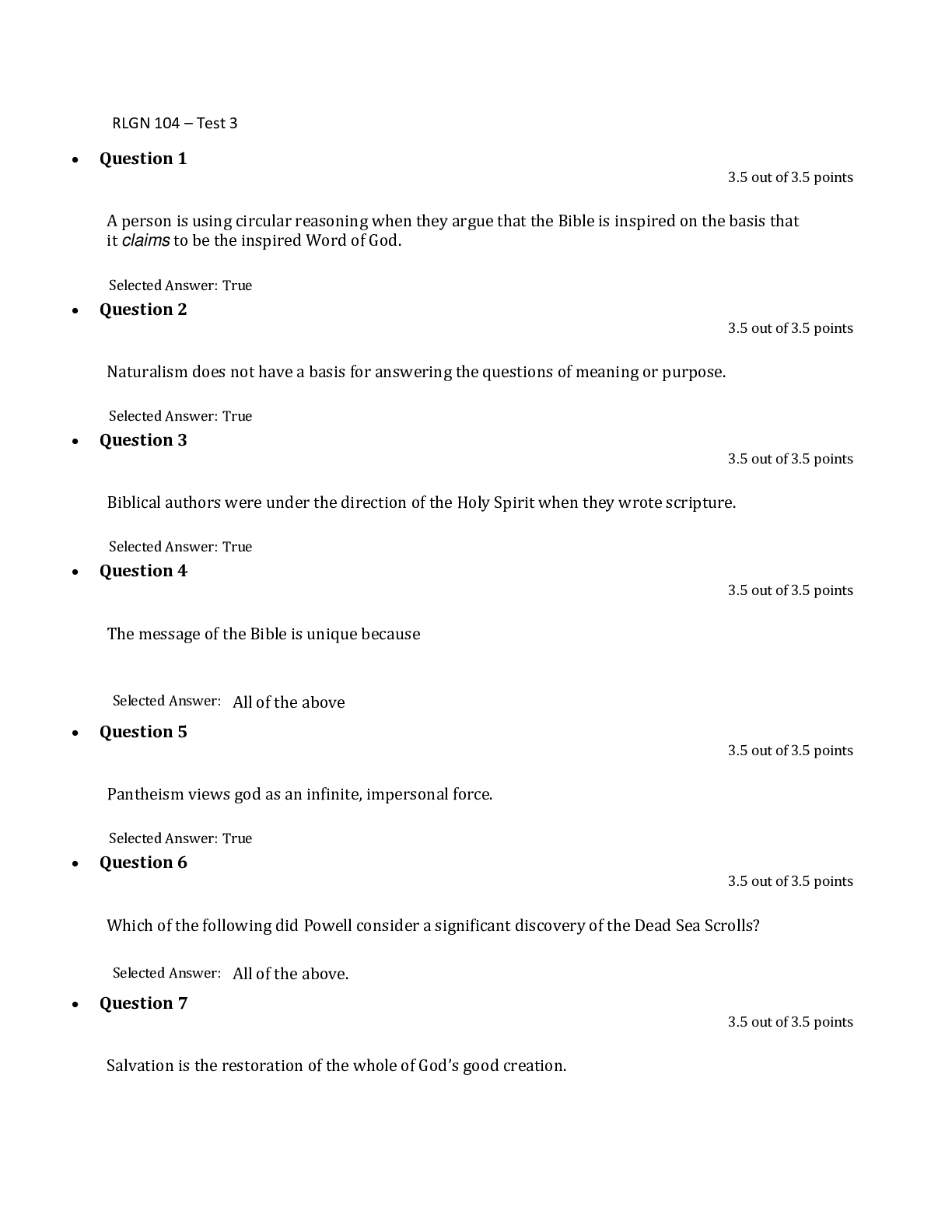
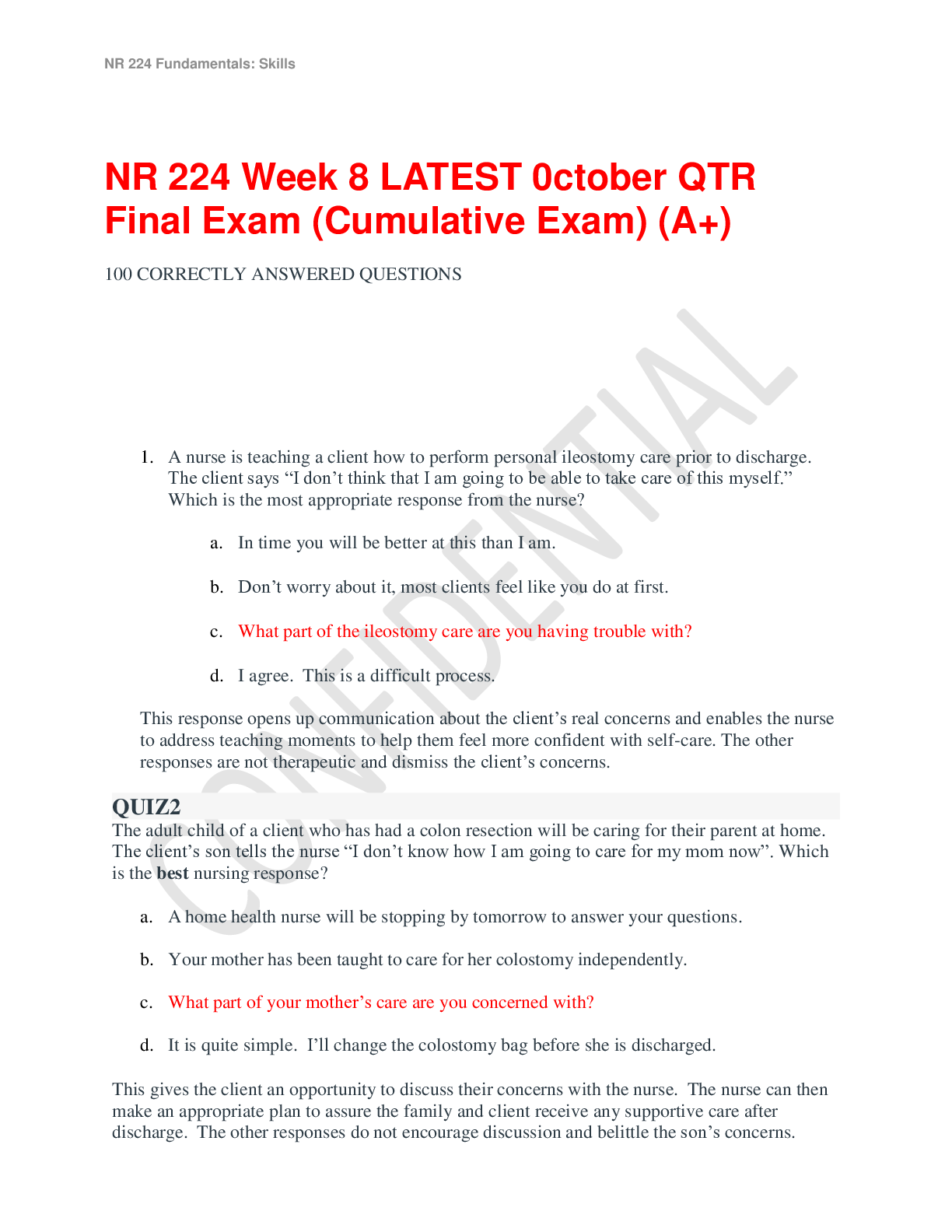




.png)




